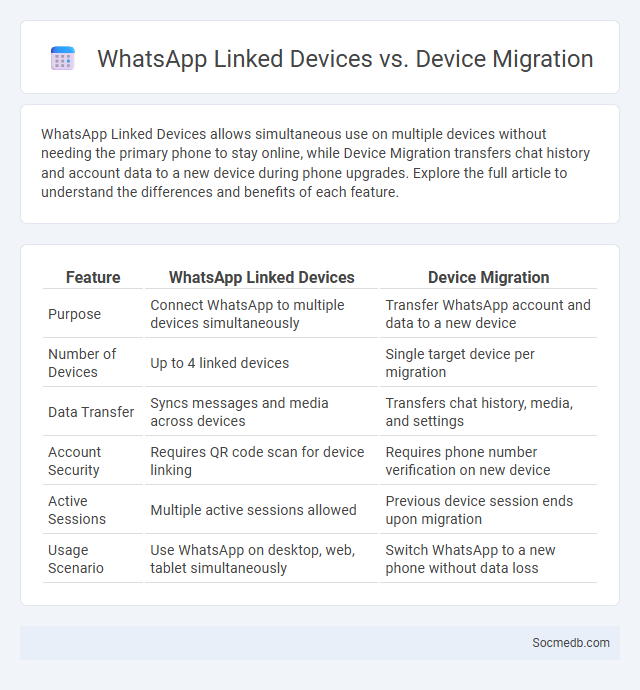
Photo illustration: WhatsApp Linked Devices vs Device Migration
WhatsApp Linked Devices allows simultaneous use on multiple devices without needing the primary phone to stay online, while Device Migration transfers chat history and account data to a new device during phone upgrades. Explore the full article to understand the differences and benefits of each feature.
Table of Comparison
| Feature | WhatsApp Linked Devices | Device Migration |
|---|---|---|
| Purpose | Connect WhatsApp to multiple devices simultaneously | Transfer WhatsApp account and data to a new device |
| Number of Devices | Up to 4 linked devices | Single target device per migration |
| Data Transfer | Syncs messages and media across devices | Transfers chat history, media, and settings |
| Account Security | Requires QR code scan for device linking | Requires phone number verification on new device |
| Active Sessions | Multiple active sessions allowed | Previous device session ends upon migration |
| Usage Scenario | Use WhatsApp on desktop, web, tablet simultaneously | Switch WhatsApp to a new phone without data loss |
Introduction to WhatsApp’s Device Features
WhatsApp's device features include multi-device support, allowing users to access their accounts on up to four linked devices without the primary phone being online. End-to-end encryption secures messages, calls, photos, and videos across all connected devices, ensuring privacy and safety. These features enhance user convenience by enabling seamless communication across smartphones, tablets, and desktop computers.
What Are WhatsApp Linked Devices?
WhatsApp Linked Devices allow you to connect multiple devices, such as computers and tablets, to your WhatsApp account, enabling seamless messaging across all platforms without needing your phone to stay online. This feature enhances user convenience by syncing chats and contacts securely through end-to-end encryption on each linked device. Your ability to manage WhatsApp on various devices simultaneously streamlines communication and boosts productivity.
Understanding WhatsApp Device Migration
WhatsApp device migration enables seamless transfer of chat history, media, and account settings across smartphones without data loss, enhancing user experience during device upgrades. The process employs end-to-end encryption to ensure privacy and security are maintained throughout data transfer. Understanding the compatibility requirements, such as operating system versions and backup methods like Google Drive or iCloud, is essential for successful migration.
Key Differences: Linked Devices vs Device Migration
Linked devices allow multiple gadgets to access the same social media account simultaneously, enabling seamless content sharing and notifications across smartphones, tablets, and computers. Device migration involves transferring account data and settings from an old device to a new one, ensuring continuity without manual reconfiguration. While linked devices enhance multi-device usability, device migration primarily supports user transition to newer hardware without losing personalized social media preferences.
Setting Up Linked Devices on WhatsApp
Setting up linked devices on WhatsApp allows you to use your account across multiple devices simultaneously while maintaining end-to-end encryption for your messages. You can link devices by opening WhatsApp on your primary phone, navigating to the Linked Devices option, and scanning the QR code displayed on your secondary device. This feature enhances your communication flexibility, ensuring you stay connected on your phone, tablet, or computer without compromising security or message synchronization.
Migrating WhatsApp Data Between Devices
Migrating WhatsApp data between devices requires backing up chats to cloud services like Google Drive for Android or iCloud for iOS to ensure seamless data transfer. Restoring WhatsApp data on a new device involves signing in with the same phone number and verifying during the setup process to retrieve chat history and media files. Using official WhatsApp migration tools reduces the risk of data loss and maintains end-to-end encryption throughout the transfer.
Security Features in Linked Devices and Device Migration
Social media platforms enhance security through features like two-factor authentication and device recognition to monitor linked devices, reducing unauthorized access risks. Device migration processes typically involve verification steps to ensure the new device is authenticated before allowing account access, protecting user data during transitions. Regular audits of linked devices and prompt removal of unrecognized devices further strengthen account security on social platforms.
Benefits and Limitations of Linked Devices
Linked devices enhance social media experiences by enabling seamless connectivity across smartphones, tablets, and computers, allowing you to access content and notifications instantly from any device. These interconnected gadgets improve efficiency in managing multiple social media accounts, but they also pose privacy risks due to increased exposure to hacking and data breaches. Balancing convenience with security measures is essential to protect your personal information while maximizing the benefits of linked device integration.
Troubleshooting Common Issues
Social media platforms often face common issues such as login problems, slow loading times, and notification errors that disrupt user experience. Troubleshooting steps include clearing your browser cache, updating the app to the latest version, and checking your internet connection to resolve these glitches efficiently. Understanding these solutions helps You maintain seamless interaction and stay connected with your online community.
Which WhatsApp Device Solution is Right for You?
Choosing the right WhatsApp device solution depends on your communication needs and business scale. WhatsApp Business App suits small businesses managing customer interactions on a single device, while WhatsApp Business API is designed for medium to large enterprises requiring multi-agent access and integration with CRM systems. Consider factors like message volume, automation capabilities, and platform compatibility to select the most effective WhatsApp solution for your operational requirements.
 socmedb.com
socmedb.com